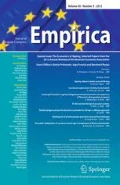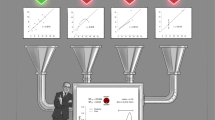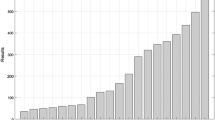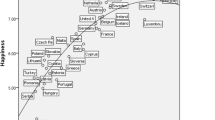Abstract
In this study we use agents’ expectations about the state of the economy to generate indicators of economic activity in twenty-six European countries grouped in five regions (Western, Eastern, and Southern Europe, and Baltic and Scandinavian countries). We apply a data-driven procedure based on evolutionary computation to transform survey variables in economic growth rates. In a first step, we design five independent experiments to derive a formula using survey variables that best replicates the evolution of economic growth in each region by means of genetic programming, limiting the integration schemes to the main mathematical operations. We then rank survey variables according to their performance in tracking economic activity, finding that agents’ “perception about the overall economy compared to last year” is the survey variable with the highest predictive power. In a second step, we assess the out-of-sample forecast accuracy of the evolved indicators. Although we obtain different results across regions, Austria, Slovakia, Portugal, Lithuania and Sweden are the economies of each region that show the best forecast results. We also find evidence that the forecasting performance of the survey-based indicators improves during periods of higher growth.




Similar content being viewed by others
References
Abberger K (2007) Qualitative business surveys and the assessment of employment—a case study for Germany. Int J Forecast 23(2):249–258
Acosta-González E, Fernández F (2014) Forecasting financial failure of firms via genetic algorithms. Comput Econ 43(2):133–157
Acosta-González E, Fernández F, Sosvilla S (2012) On factors explaining the 2008 financial crisis. Econ Lett 115(2):215–217
Alexandridis AK, Kampouridis M, Cramer S (2017) A comparison of wavelet networks and genetic programming in the context of temperature derivatives. Int J Forecast 33(1):21–47
Altug S, Çakmakli C (2016) Forecasting inflation using survey expectations and target inflation: evidence from Brazil and Turkey. Int J Forecast 32(1):138–153
Álvarez-Díaz M, Álvarez A (2005) Genetic multi-model composite forecast for non-linear prediction of exchange rates. Empir Econ 30(3):643–663
Anderson O (1952) The business test of the IFO-Institute for Economic Research, Munich, and its theoretical model. Rev l’Inst Int Stat 20:1–17
Balcombe K (1996) The Carlson–Parkin method applied to NZ price expectations using QSBO survey data. Econ Lett 51(1):51–57
Banzhaf W, Nordin P, Keller RE, Francone FD (2008) Genetic programming: an introduction. On the automatic evolution of computer programs and its applications. Morgan Kaufmann, San Francisco, CA
Barmpalexis P, Kachrimanis K, Tsakonas A, Georgarakis E (2011) Symbolic regression via genetic programming in the optimization of a controlled release pharmaceutical formulation. Chemometr Intell Lab Syst 107(1):75–82
Batchelor RA (1981) Aggregate expectations under the stable laws. J Econom 16(2):199–210
Batchelor RA (1982) Expectations, output and inflation: the European experience. Eur Econ Rev 17(1):1–25
Batchelor RA (1986) Quantitative v. qualitative measures of inflation expectations. Oxf Bull Econ Stat 48(2):99–120
Batchelor R, Dua P (1992) Survey expectations in the time series consumption function. Rev Econ Stat 74(4):598–606
Batchelor R, Dua P (1998) Improving macro-economic forecasts. Int J Forecast 14(1):71–81
Batchelor R, Orr AB (1988) Inflation expectations revisited. Economica 55(2019):317–331
Bennett A (1984) Output expectations of manufacturing industry. Appl Econ 16(6):869–879
Bergström R (1995) The relationship between manufacturing production and different business survey series in Sweden 1968–1992. Int J Forecast 11(3):379–393
Berk JM (1999) Measuring inflation expectations: a survey data approach. Appl Econ 31(11):1467–1480
Białowolski P (2016) The influence of negative response style on survey-based household inflation expectations. Qual Quant 50(2):509–528
Bovi M (2013) Are the representative agent’s beliefs based on efficient econometric models? J Econ Dyn Control 37(3):633–648
Bovi M (2016) The tale of two expectations. Qual Quant 50(6):2677–2705
Breitung J, Schmeling M (2013) Quantifying survey expectations: What’s wrong with the probability approach? Int J Forecast 29(1):142–154
Bruestle S, Crain WM (2015) A mean-variance approach to forecasting with the consumer confidence index. Appl Econ 47(23):2430–2444
Bruno G (2014) Consumer confidence and consumption forecast: a non-parametric approach. Empirica 41(1):37–52
Carlson JA, Parkin M (1975) Inflation expectations. Economica 42(166):123–138
Ceperic V, Bako N, Baric A (2014) A symbolic regression-based modelling strategy of AC/DC rectifiers for RFID applications. Expert Syst Appl 41(16):7061–7067
Chen SH, Kuo TW (2002) Evolutionary computation in economics and finance: a bibliography. In: Chen SH (ed) Evolutionary computation in economics and finance. Physica-Verlag, Heidelberg, pp 419–455
Chen SH, Kuo TW, Hoi KM (2008) Genetic programming and financial trading: how much about “what we know”. In: Zopounidis C et al (eds) Handbook of financial engineering. Springer, New York, pp 99–154
Chen X, Pang Y, Zheng G (2010) Macroeconomic forecasting using GP based vector error correction model. In: Wang J (ed) Business intelligence in economic forecasting: technologies and techniques. IGI Global, Hershey, pp 1–15
Christiansen C, Eriksen J, Moller S (2014) Forecasting US recessions: the role of sentiment. J Bank Finance 49:459–468
Claveria O (2010) Qualitative survey data on expectations. Is there an alternative to the balance statistic? In: Molnar AT (ed) Economic forecasting. Nova Science Publishers, Hauppauge, pp 181–190
Claveria O, Pons E, Suriñach J (2006) Quantification of expectations. Are they useful for forecasting inflation? Economic Issues 11(2):19–38
Claveria O, Pons E, Ramos R (2007) Business and consumer expectations and macroeconomic forecasts. Int J Forecast 23(1):47–69
Claveria O, Monte E, Torra S (2015) A new forecasting approach for the hospitality industry. Int J Contemp Hosp Manage 27(7):1520–1538
Claveria O, Monte E, Torra S (2016) Quantification of survey expectations by means of symbolic regression via genetic programming to estimate economic growth in Central and Eastern European economies. Eastern European Economics 54(2):177–189
Claveria O, Monte E, Torra S (2017) A new approach for the quantification of qualitative measures of economic expectations. Qual Quant 51(6):2685–2706
Common M (1985) Testing for rational expectations with qualitative survey data. Manch Sch Econ Soc Stat 53(2):138–148
Cowles A, Jones H (1937) Some a posteriori probabilities in stock market action. Econometrica 5(3):280–294
Cramer N (1985) A representation for the adaptive generation of simple sequential programs. In: Proceedings of the international conference on genetic algorithms and their applications, 24–26 June. Pittsburgh, PA
Dabhi VK, Chaudhary S (2015) Empirical modeling using genetic programming: a survey of issues and approaches. Nat Comput 14(2):303–330
Dees S, Brinca PS (2013) Consumer confidence as a predictor of consumption spending: evidence for the United States and the Euro area. Int Econ 134:1–14
Drake AE, Marks RE (2002) Genetic algorithms in economics and finance: forecasting stock market prices and foreign exchange—a review. In: Chen SH (ed) Genetic algorithms and genetic programming in computational finance. Springer, New York, pp 29–54
Dreger C, Kholodilin D (2013) Forecasting private consumption by consumer surveys. J Forecast 32(1):10–18
Driver C, Urga G (2004) Transforming qualitative survey data: performance comparisons for the UK. Oxf Bull Econ Stat 66(1):71–89
Duda J, Szydło S (2011) Collective intelligence of genetic programming for macroeconomic forecasting. In: Jędrzejowicz P et al (eds) Computational collective intelligence. Technologies and applications. Springer, Berlin, pp 445–454
Ferreira C (2001) Gene expression programming: a new adaptive algorithm for solving problems. Complex Syst 13(2):87–129
Fogel DB (2006) Evolutionary computation. Toward a new philosophy of machine intelligence, 3rd edn. Wiley, Hoboken
Fogel LJ, Owens AJ, Walsh MJ (1966) Artificial intelligence through simulated evolution. John Wiley, New York
Fortin FA, De Rainville FM, Gardner MA, Parizeau M, Gagné C (2012) DEAP: evolutionary algorithms made easy. J Mach Learn Res 13(1):2171–2175
Franses PH, Kranendonk HC, Lanser D (2011) One model and various experts: evaluating Dutch macroeconomic forecasts. Int J Forecast 27(2):482–495
Gandomi AH, Roke D (2015) Assessment of artificial neural network and genetic programming as predictive tools. Adv Eng Softw 88:63–72
Garnitz J, Nerb G, Wohlrabe K (2015) CESifo World Economic Survey—November 2015. CESifo World Econ Survey 14(4):1–28
Ghonghadze J, Lux T (2012) Modelling the dynamics of EU economic sentiment indicators: an interaction-based approach. Appl Econ 44(24):3065–3088
Girardi A (2014) Expectations and macroeconomic fluctuations in the Euro area. Econ Lett 125(2):315–318
Goldberg DE (1989) Genetic algorithms in search, optimization, and machine learning. Addison-Wesley, Boston
Gong YJ, Chen WN, Zhan ZH, Zhang J, Li Y, Zhang Q, Li JJ (2015) Distributed evolutionary algorithms and their models: a survey of the stat-of-the-art. Appl Soft Comput 34:286–300
Graff M (2010) Does a multi-sectoral design improve indicator-based forecasts of the GDP growth rate? Evidence from Switzerland. Appl Econ 42(21):2759–2781
Guizzardi A, Stacchini A (2015) Real-time forecasting regional tourism with business sentiment surveys. Tour Manag 47:213–223
Hansson J, Jansson P, Löf M (2005) Business survey data: Do they help in forecasting GDP growth? Int J Forecast 30(1):65–77
Holland JH (1975) Adaptation in natural and artificial systems. University of Michigan Press, Ann Arbor
Hutson M, Joutz F, Stekler H (2014) Interpreting and evaluating CESIfo’s World Economic Survey directional forecasts. Econ Model 38:6–11
Hyndman RJ, Koehler AB (2006) Another look at measures of forecast accuracy. Int J Forecast 22(4):679–688
Ivaldi M (1992) Survey evidence on the rationality of expectations. J Appl Econom 7(3):225–241
Jean-Baptiste F (2012) Forecasting with the new Keynesian Phillips curve: evidence from survey data. Econ Lett 117(3):811–813
Jonsson T, Österholm P (2011) The forecasting properties of survey-based wage-growth expectations. Econ Lett 113(3):276–281
Jonsson T, Österholm P (2012) The properties of survey-based inflation expectations in Sweden. Empir Econ 42(1):79–94
Kaboudan MA (2000) Genetic programing prediction of stock prices. Comput Econ 16(3):207–236
Klein LR, Özmucur S (2010) The use of consumer and business surveys in forecasting. Econ Model 27(6):1453–1462
Kłopocka K (2017) Does consumer confidence forecast household saving and borrowing behavior? Evidence for Poland. Soc Indic Res 133(2):693–717
Klúčik M (2012) Estimates of foreign trade using genetic programming. In: Proceedings of the 46 the scientific meeting of the Italian Statistical Society
Kotanchek ME, Vladislavleva EY, Smits GF (2010) Symbolic regression via genetic programming as a discovery engine: insights on outliers and prototypes. In: Riolo R et al (eds) Genetic programming theory and practice VII, genetic and evolutionary computation, vol 8. Springer, Berlin, pp 55–72
Koza JR (1992) Genetic programming: on the programming of computers by means of natural selection. MIT Press, Cambridge
Kronberger G, Fink S, Kommenda M, Affenzeller M (2011) Macro-economic time series modeling and interaction networks. In: Di Chio C et al (eds) Applications of evolutionary computation. EvoApplications 2011. Lecture Notes in Computer Science, vol 6625. Springer, Berlin, Heidelberg, pp 101–110
Kudymowa E, Plenk J, Wohlrabe K (2013) Ifo World Economic Survey and the business cycle in selected countries. CESifo Forum 14(4):51–57
Kumar V, Leone R, Gaskins J (1995) Aggregate and disaggregate sector fore-casting using consumer confidence measures. Int J Forecast 11(3):361–377
Lacová Ž, Král P (2015) Measurement and characteristics of enterprise inflation expectations in Slovakia. Proc Econ Finance 30:505–512
Lahiri K, Teigland C (1987) On the normality of probability distributions of inflation and GNP forecasts. Int J Forecast 3(2):269–279
Lahiri K, Zhao Y (2015) Quantifying survey expectations: a critical review and generalization of the Carlson–Parkin method. Int J Forecast 31(1):51–62
Lahiri K, Monokroussos G, Zhao Y (2016) Forecasting consumption: the role of consumer confidence in real time with many predictors. J Appl Econom 31(7):1254–1275
Larkin F, Ryan C (2008) Good news: using news feeds with genetic programming to predict stock prices. In: O’Neil M et al (eds) Genetic programming. Springer, Berlin, pp 49–60
Lawrenz C, Westerhoff F (2003) Modeling exchange rate behaviour with a genetic algorithm. Comput Econ 21(3):209–229
Leduc S, Sill K (2013) Expectations and economic fluctuations: an analysis using survey data. Rev Econ Stat 95(4):1352–1367
Lee KC (1994) Formation of price and cost inflation expectations in British manufacturing industries: a multi-sectoral analysis. Econ J 104(423):372–385
Lehmann R, Wohlrabe K (2017) Experts, firms, consumers or even hard data? Forecasting employment in Germany. Appl Econ Lett 24(4):279–283
Lemmens A, Croux C, Dekimpe MG (2005) On the predictive content of production surveys: a pan-European study. Int J Forecast 21(2):363–375
Löffler G (1999) Refining the Carlson–Parkin method. Econ Lett 64(2):167–171
Lui S, Mitchell J, Weale M (2011a) The utility of expectational data: firm-level evidence using matched qualitative-quantitative UK surveys. Int J Forecast 27(4):1128–1146
Lui S, Mitchell J, Weale M (2011b) Qualitative business surveys: signal or noise? J R Stat Soc Ser A (Stat Soc) 174(2):327–348
Łyziak T, Mackiewicz-Łyziak J (2014) Do consumers in Europe anticipate future inflation? Eastern Eur Econ 52(3):5–32
Maag T (2009) On the accuracy of the probability method for quantifying beliefs about inflation. KOF Working Papers, No. 230, KOF Swiss Economic Institute, Zurich
Makridakis S, Hibon M (2000) The M3-competition: results, conclusions and implications. Int J Forecast 16(4):451–476
Martinsen K, Ravazzolo F, Wulfsberg F (2014) Forecasting macroeconomic variables using disaggregate survey data. Int J Forecast 30(1):65–77
Maschek MK (2010) Intelligent mutation rate control in an economic application of genetic algorithms. Comput Econ 35(1):25–49
Miah F, Rahman MS, Albinali K (2016) Rationality of survey based inflation expectations: a study of 18 emerging economies’ inflation forecasts. Res Int Bus Finance 36:158–166
Mitchell J, Smith R, Weale M (2002) Quantification of qualitative firm-level survey data. Econ J 112(478):117–135
Mitchell J, Smith R, Weale M (2005a) Forecasting manufacturing output growth using firm-level survey data. Manch Sch 73(4):479–499
Mitchell J, Smith R, Weale M (2005b) An indicator of monthly GDP and an early estimate of quarterly GDP growth. Econ J 115(501):F108–F129
Mittnik S, Zadrozny P (2005) Forecasting quarterly German GDP at monthly intervals using monthly IFO business conditions data. In: Sturm JE, Wollmershäuser T (eds) IFO survey data in business cycle analysis and monetary policy analysis. Physica-Verlag, Heidelberg, pp 19–48
Mokinski F, Sheng X, Yang J (2015) Measuring disagreement in qualitative expectations. J Forecast 34(5):405–426
Müller C (2010) You CAN Carlson–Parkin. Econ Lett 108(1):33–35
Muth J (1961) Rational expectations and the theory of price movements. Econometrica 29(3):315–335
Nardo M (2003) The quantification of qualitative data: a critical assessment. J Econ Surveys 17(5):645–668
Nardo M, Cabeza-Gutés M (1999) The role of measurement error in rational expectations testing. UAB Working Paper 451, Universitat Autònoma de Barcelona, Barcelona
Nolte I, Pohlmeier W (2007) Using forecasts of forecasters to forecast. Int J Forecast 23(1):15–28
Paloviita M (2006) Inflation dynamics in the euro area and the role of expectations. Empir Econ 31:847–860
Peng Y, Yuan C, Qin X, Huang J, Shi Y (2014) An improved gene expression programming approach for symbolic regression problems. Neurocomputing 137:293–301
Pesaran MH (1985) Formation of inflation expectations in British manufacturing industries. Econ J 95(380):948–975
Pesaran MH (1987) The limits to rational expectations. Basil Blackwell, Oxford
Pesaran MH, Weale M (2006) Survey expectations. In: Elliott G, Granger CWJ, Timmermann A (eds) Handbook of economic forecasting, vol 1. Elsevier North-Holland, Amsterdam, pp 715–776
Poli R, Vanneschi L, Langdon WB, Mcphee NF (2010) Theoretical results in genetic programming: the next ten years? Genet Program Evolvable Mach 11(3):285–320
Qiao Z, McAleer M, Wong WK (2009) Linear and nonlinear causality between changes in consumption and consumer attitudes. Econ Lett 102(3):161–164
Robinzonov N, Tutz G, Hothorn T (2012) Boosting techniques for nonlinear time series models. AStA Adv Stat Anal 96(1):99–122
Sarradj E, Geyer T (2014) Symbolic regression modeling of noise generation at porous airfoils. J Sound Vib 333(14):3189–3202
Schmeling M, Schrimpf A (2011) Expected inflation, expected stock returns, and money illusion: what can we learn from survey expectations. Eur Econ Rev 55(5):702–719
Seitz H (1988) The estimation of inflation forecasts from business survey data. Appl Econ 20(4):427–438
Smith J, McAleer M (1995) Alternative procedures for converting qualitative response data to quantitative expectations: an application to Australian manufacturing. J Appl Econom 10(2):165–185
Terai A (2009) Measurement error in estimating inflation expectations from survey data: an evaluation by Monte Carlo simulations. J Bus Cycle Meas Anal 8(2):133–156
Theil H (1952) On the time shape of economic microvariables and the Munich Business Test. Rev l’Inst Int Stat 20:105–120
Thinyane H, Millin J (2011) An investigation into the use of intelligent systems for currency trading. Comput Econ 37(4):363–374
Vasilakis GA, Theofilatos KA, Georgopoulos EF, Karathanasopoulos A, Likothanassis SD (2013) A genetic programming approach for EUR/USD exchange rate forecasting and trading. Comput Econ 42(4):415–431
Vermeulen P (2014) An evaluation of business survey indices for short-term forecasting: balance method versus Carlson–Parkin method. Int J Forecast 30(4):882–897
Visco I (1984) Price expectations in rising inflation. North-Holland, Amsterdam
Vladislavleva E, Smits G, den Hertog D (2010) On the importance of data balancing for symbolic regression. IEEE Trans Evol Comput 14(2):252–277
Wei LY (2013) A hybrid model based on ANFIS and adaptive expectation genetic algorithm to forecast TAIEX. Econ Model 33:893–899
Wilms I, Gelper S, Croux C (2016) The predictive power of the business and bank sentiment of firms: a high-dimensional Granger Causality approach. Eur J Oper Res 254(1):138–147
Wilson G, Banzhaf W (2009) Prediction of interday stock prices using developmental and linear genetic programming. In: Giacobini M et al (eds) Applications of evolutionary computing. Springer, Berlin, pp 172–181
Wren-Lewis S (1986) An econometric model of U.K. manufacturing employment using survey data on expected output. J Appl Econom 10(2):165–185
Wu CH, Chou HJ, Su WH (2008) Direct transformation of coordinates for GPS positioning using the techniques of genetic programming and symbolic regression. Eng Appl Artif Intell 21(8):1347–1359
Yang G, Li X, Wang J, Lian L, Ma T (2015) Modeling oil production based on symbolic regression. Energy Policy 82(1):48–61
Yao L, Lin CC (2009) Identification of nonlinear systems by the genetic programming-based volterra filter. IET Signal Proc 3(2):93–105
Yu T, Chen S, Kuo TW (2004) A genetic programming approach to model international short-term capital flow. Appl Artif Intell Finance Econ 19:45–70
Zameer A, Arshad J, Khan A, Raja MAZ (2017) Intelligent and robust prediction of short term wind power using genetic programming based ensemble of neural networks. Energy Convers Manag 134:361–372
Zelinka I, Oplatkova Z, Nolle L (2005) Analytic programming: symbolic regression by means of arbitrary evolutionary algorithms. Int J Simul Syst Sci Technol 6(9):44–56
Acknowledgements
This research was supported by the Projects ECO2016-75805-R and TEC2015-69266-P from the Spanish Ministry of Economy and Competitiveness. We would like to thank the Editor and two anonymous referees for their useful comments and suggestions We also wish to thank Johanna Garnitz and Klaus Wohlrabe at the Ifo Institute for Economic Research in Munich for providing us the data used in the study.
Author information
Authors and Affiliations
Corresponding author
Electronic supplementary material
Below is the link to the electronic supplementary material.
Rights and permissions
About this article
Cite this article
Claveria, O., Monte, E. & Torra, S. Empirical modelling of survey-based expectations for the design of economic indicators in five European regions. Empirica 46, 205–227 (2019). https://doi.org/10.1007/s10663-017-9395-1
Published:
Issue Date:
DOI: https://doi.org/10.1007/s10663-017-9395-1
Keywords
- Economic indicators
- Qualitative survey data
- Expectations
- Symbolic regression
- Evolutionary algorithms
- Genetic programming




